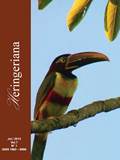Seed quality individuals natives Dalbergia miscolobium Benth. in area of savanna recovery process
DOI:
https://doi.org/10.17648/heringeriana.v7i1.7Keywords:
seeds production, predation, degraded areas recoveryAbstract
The aim study was to quantify and compare the seeds quality of Dalbergia miscolobium
Benth. four matrices from an area of dirty field in Diamantina, Minas Gerais, in a two years recovery process (2010 and 2011). The collected seeds were classified as predation, immature and mature. The results were compared between two years through contingency table. We applied t test
for dependent samples, 95% confidence interval for the data quality samples between years. The samples 2010 and 2011 in seeds qualities were, respectively, 52,25% and 5,5% seeds predated, 33,5% and 33,5% seeds immature, and 14,25% and 61% seeds mature. Significant difference was observed for the variables related to the quality predated seeds and seeds mature between the years. Found that the seeds quality of D. miscolobium fluctuated in the two years evaluated resulting possible fluctuations in the density of individuals the population database natural regeneration.
References
ABREU, T.A.L.; PINTO, J.R.R.; LENZA, E.; MEWS, H.A. & SANTOS, T.R.R. 2012. Composição florística e estrutura da vegetação arbustivo-arbórea em cerrado sentido restrito na Serra de Jaraguá, Goiás, Brasil. Heringeriana 6(2):42-53.
APG III – Angiosperm Phylogeny Group. 2009. An update of the Angiosperm Phylogeny Group
classification for the orders and families of flowering plants: APG III. Botanical Journal of the
Linnean Society 161:105-121.
BAWA, K.S. & WEBB, C.J. 1984. Flower, fruit and seed abortion in tropical forest trees: implications for the evolution of paternal and maternal reproductive patters. American Journal of Botany 71:736-751.
CARPANEZZI, A.A. 2005. Fundamentos para a reabilitação de ecossistemas florestais. In: A.P.M.
Galvão & V.P Silva (eds.). Restauração florestal: fundamentos e estudos de caso. Embrapa: Colombo-
PR; p. 27-45.
GIBBS, P. & SASSAKI, R. 1998. Reproductive Biology of Dalbergia miscolobium Benth. (Leguminosae-Papilionoideae) in SE, Brazil: the Effects of Pistillate sorting on fruit-set. Annals of Botany 81: 735-740.
LEE, T.D. 1988. Patterns of fruit and seed production. In: J. Lovett-Doust & L. Lovett-Doust (eds.). Plant reproductive ecology: patterns and strategies. Oxford: OUP. 179–202.
NEVES, S.C.; ABREU, P.A.A. & FRAGA, L.M.S. 2005. Fisiografia. In: A.C. Silva; L.C.V.S.F. Pedreira & P.A.A. Abreu. Serra do Espinhaço Meridional, Paisagens e Ambientes. Belo Horizonte: O Lutador. p. 47-58
PEREIRA, I.M.; BOTELHO, S.A.; VAN DER BERG, E.; OLIVEIRA-FILHO, A.T. & MACHADO, E.L.M. 2010. Caracterização ecológica de espécies arbóreas ocorrentes em ambientes de mata ciliar, como subsídio à recomposição de áreas alteradas nas cabeceiras do Rio Grande, Minas Gerais, Brasil. Revista Ciência Florestal 20(2):235-253.
PINTO, J.R.R.; BORDINI, M.C.P.; PORTO, A.C. & SOUSA-SILVA, J.C. 2011. Princípios e técnicas usadas na recuperação de áreas degradadas. In: C.W. Fagg; C.B.R. Munhoz & J.C. Sousa-Silva. Conservação de áreas de preservação permanente do Cerrado: caracterização, Educação Ambiental e manejo. Brasília: CRAD. p. 148-184.
RIBEIRO, M.L.; SALES, V.A.; MIRANDA, F.S.; SOARES, C.E.A. & OLIVEIRA, S.C.C. 2007. Influência da Predação de Sementes na Germinação de Leguminosas (Fabaceae) no Cerrado. Revista Brasileira de Biociências 5(2):279-281.
SANO, E.E.; ROSA, R.; BRITO, J.L.S. & FERREIRA-JUNIOR., L.G. 2010. Land cover mapping of the tropical savanna region in Brazil. Environmental Monitoring and Assessment 166:113-124.
SILVA, T.R.G.; CORTELAZZO, A.L.; DIETRICH; S.M.C. 1997. Cytological aspects of storage mobilization in seeds of Dalbergia miscolobium during germination and plantlet growth. Ciência e Cultura 9(3):219-222.
SILVA-JÚNIOR, M.C.; SANTOS, G.C.; NOGUEIRA, P.E.; MUNHOZ, C.B.R. & RAMOS, A.E. 2005. 100 árvores do Cerrado: guia de campo. Brasília: Rede de sementes do Cerrado. 278p.
STATSOFT, INC. 2011. Statistica (data analysis software system); version 10. Disponível em: www.statsoft.com.
ZAR, J.H. 2010. Bioestatistical Analysis. (5a ed.). Prentice-Hall, New Jersey, p.736-746.
Downloads
Published
How to Cite
Issue
Section
License
Copyright (c) 2014 Milton Serpa de Meira Júnior, Evandro Luiz Mendonça Machado, Márcio Leles Romarco de Oliveira, José Roberto Rodrigues Pinto, Sílvia da Luz Lima Mota

This work is licensed under a Creative Commons Attribution 4.0 International License.
By submitting, the authors declare that they have not submitted the work to another journal and agree to have their article published under a Creative Commons Attribution 4.0 International BY License (CC BY 4.0), which means that authors retain ownership of the copyright but anyone can use the published content provided the original authors and source are cited. The scientific, orthographic and grammatical content is the full responsibility of the authors.








